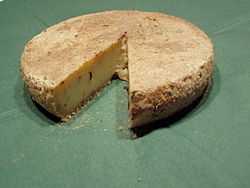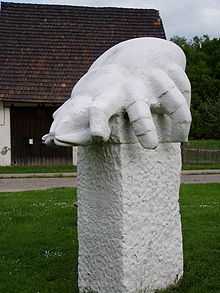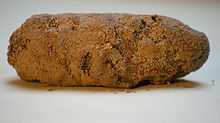Milbenkäse

Milbenkäse ("mite cheese"), called Mellnkase in the local dialect and often (erroneously) known as Spinnenkäse ("spider cheese"), is a German specialty cheese made from quark and produced using the action of cheese mites. Historically, the cheese was produced in the Saxony-Anhalt/Thuringia border region of Zeitz and Altenburg districts; today it is produced exclusively in the village of Würchwitz, in the state of Saxony-Anhalt.

The traditional method of making Milbenkäse, which dates back to the Middle Ages, was nearly lost by 1970, with only the elderly Liesbeth Brauer knowing the technique. Local science teacher Helmut Pöschel was taught the proper way to make Milbenkäse and together with his associate Christian Schmelzer managed to revitalize the tradition. A memorial was later erected at Würchwitz to celebrate the renaissance of Milbenkäse production. The rear side of the memorial is hollow and is regularly stocked with small bits of Milbenkäse for passersby and tourists to try.
Milbenkäse is said to taste similar to Harzer cheese, but with a bitter note (increasing with age) and a distinctive zesty aftertaste. Mites clinging to the cheese rind are consumed along with the cheese.
Production

Quark flavoured with salt and caraway is shaped into small balls, cylinders or wheels, and dried. Then it is placed in a wooden box containing rye flour and inhabited by Tyrophagus casei mites for at least three months. The digestive juices of the mites diffuse into the cheese and cause fermentation; the flour is added because the mites would otherwise simply eat the whole cheese instead of just nibbling away at the crust as is desired. After one month, the cheese rind turns yellow; after three months, reddish-brown. Some producers allow the cheese to ripen for up to one year, until it has turned black.
Legality
Milbenkäse falls into something of a legal grey area: EU Regulation 178/2002 allows the sale of foodstuffs containing living animals if they are "prepared for placing on the market for human consumption".[1] On the other hand, cheese mites or their digestive juices are not explicitly permitted as additives for cheese according to the relevant German food ordinances (Zusatzstoff-Zulassungsverordnung and Käseverordnung). Milbenkäse is produced under a permit by the local food safety office and HACCP compliance of the product is enforced.
Similar cheeses
Cheese mites are used in cheese maturing elsewhere. The most famous example is probably Mimolette from northeastern France and nearby Belgium. Other French cheeses - mainly from the Massif Central, the French Alps and the Pyrenees - sometimes host cheese mites in their crust more (e.g. old Cantal and Salers) or less (e.g. certain Tomme de Montagne varieties) by accident. But most of these cheeses are semi-hard to hard rennet cheeses, whereas Milbenkäse is a softer sour milk cheese.
The Spanish Cabrales cheese of the Asturias region also contains living cheese mites, though they are few in number, inhabit the mold canals, and take no significant part in the maturation of this blue cheese.[citation needed]
Another cheese that contains living animals is Casu marzu, which contains larvae of the cheese fly.
See also
References
External links
| Wikimedia Commons has media related to Milbenkäse. |
- This article draws heavily on the corresponding article in the German-language Wikipedia.